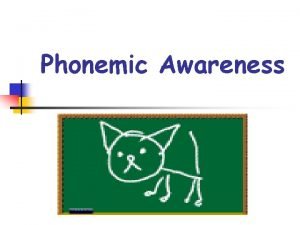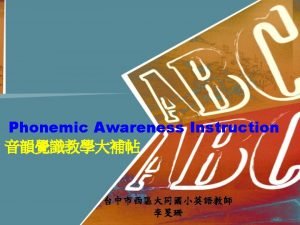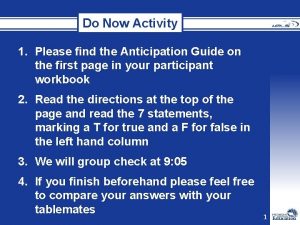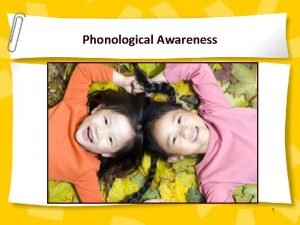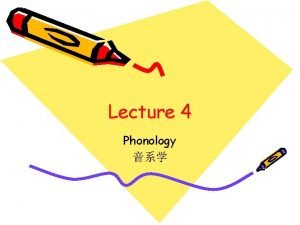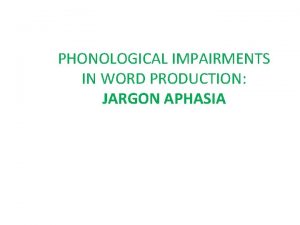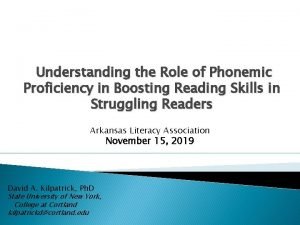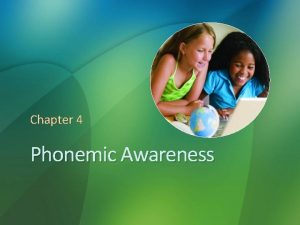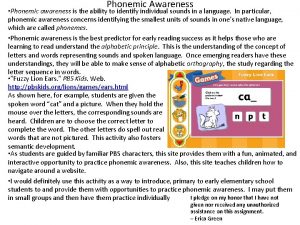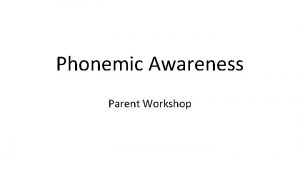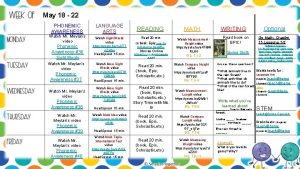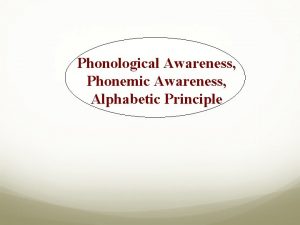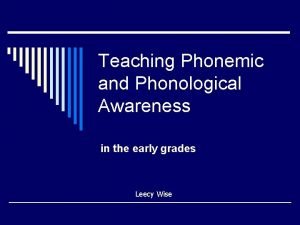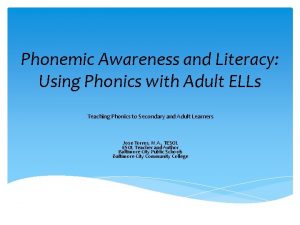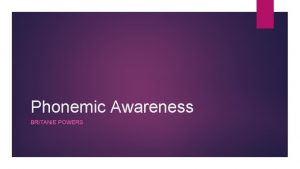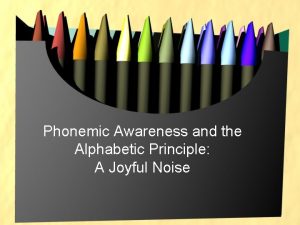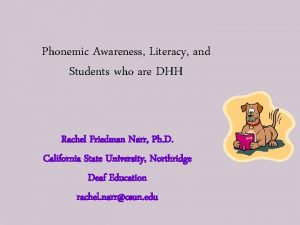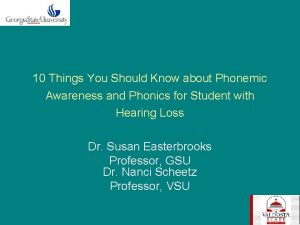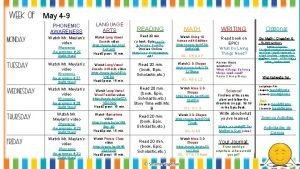Phonemic Awareness Phonemic Awareness Phonemic Awareness is the



















- Slides: 19

Phonemic Awareness

Phonemic Awareness:

Phonemic Awareness: • is the understanding that a spoken word is made up of individual sounds. – – is associated with sounds in spoken words. involves listening skills is a strong predictor of reading success is the ability to blend, segment, and manipulate sounds in spoken words – instruction begins with young children

Phonemes: • A phoneme is a speech sound. • It is the smallest unit of sound that makes a difference in meaning. • Approximately 40 different phonemes in English

Importance of phonemic Awareness:

Why is Phonemic Awareness important: • Phoneme blending and segmentation were found to produce the greatest benefits for reading and spelling. • Research indicates that phonemic awareness helps students make connections to reading when students are taught to manipulate phonemes with letters of the alphabet.

• Learning a new word involves forming a connection between visual information about the word as it appears in print and its meaning, pronunciation, and other information that is stored in the child’s oral vocabulary. • This connection is what enables the reader to access information about the word stored in the brain when the word is encountered in print. • Faster, stronger connections help produce more proficient reading.

Strategies for improving Phonemic Awareness:

Isolating phonemes: • Students identify specific sounds at the beginning, middle, and end of words. • Teacher (T): What is the first sound in the word dog? Student (S): /d/

Blending onset-rimes • Students blend onsetrimes to form real words. • (The onset is the leading consonant(s) in a syllable; the rime is the vowel(s) and following consonants. )

Blending phonemes • Students blend phonemes to form real words.

Deleting phonemes • Students identify the word that remains when a phoneme is removed or deleted. • T: What word is left when we drop the /s/ from the word spot? S: pot

Segmenting words into phonemes • Students break a word into its individual sounds by counting the sounds or by moving a marker for each sound. • T: Show me how many phonemes are there in the word bake. S: three — /b/ /a/ /k/

Adding phonemes • Students make new words by adding a phoneme to a word. • T: What word do you make when you add a /b/ to the beginning of the word ring? S: bring

Substituting phonemes • Students make a new word by replacing a specified phoneme with another. • T: Say the word bag. Now change the /b/ to an /r/. What is the new word? S: rag

Strategies: Other activities:

Games that are helpful to students: • Rhyming Sounds: "What words rhyme with pan? For instance, man rhymes with pan. " 2. Beginning Sounds: "How many words can you make that start with the "b" sound? “ 3. Ending Sounds: "How many words can you make that end with the "t" sound? “ 4. Rhyming Beginning Sounds: "What word rhymes with cat but starts with the "b" sound? "

Games that can help students cont. : • 5. Dropping Sounds: "What happens when you drop the "m" sound off of Mike's name? “ 6. Substitute Sounds: "What happens when you change the "t" in Tom to the "m" sound? “ 7. Counting Sounds: "How many sounds can you hear in the word pig? " Say each sound. 8. Common Sounds: "What sound do all of these words have in common: snake, sit, sleep? “ 9. Blending Sounds: "What word is made of these sounds: "d" and "o" and "g"?

Internet Sites that are helpful: • http: //teacher. scholastic. com/activities/bll/index. htm • http: //www. starfall. com/n/level-a/learn-toread/play. htm? f • http: //teacher. scholastic. com/clifford 1/flash/phonics/i ndex. htm • http: //pbskids. org/lions/games/blending. html • http: //www. bbc. co. uk/schools/wordsandpictures/long vow/spelling. shtm • http: //www. bbc. co. uk/schools/wordsandpictures/clust ers/blender/game. shtml
 Phonemic awareness, sioux falls
Phonemic awareness, sioux falls Phonemic awareness definition
Phonemic awareness definition Phonemic awareness ppt
Phonemic awareness ppt Phonemic awareness in young children
Phonemic awareness in young children Phonemic awareness
Phonemic awareness Language flashcards
Language flashcards Phonemic awareness
Phonemic awareness Phonological awareness continuum chart
Phonological awareness continuum chart Sound walls for reading
Sound walls for reading Narrow transcription
Narrow transcription Phonetically definition
Phonetically definition Jargon aphasia example
Jargon aphasia example Phonemic proficiency
Phonemic proficiency Cvs privacy awareness and hipaa training answers
Cvs privacy awareness and hipaa training answers Thiếu nhi thế giới liên hoan
Thiếu nhi thế giới liên hoan Phối cảnh
Phối cảnh Một số thể thơ truyền thống
Một số thể thơ truyền thống Các châu lục và đại dương trên thế giới
Các châu lục và đại dương trên thế giới Thế nào là hệ số cao nhất
Thế nào là hệ số cao nhất Sơ đồ cơ thể người
Sơ đồ cơ thể người

